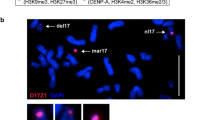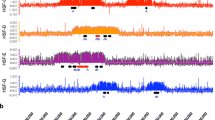Abstract
Endogenous human centromeres form on megabase-sized arrays of tandemly repeated alpha satellite DNA. Human neocentromeres form epigenetically at ectopic sites devoid of alpha satellite DNA and permit analysis of centromeric DNA and chromatin organization. In this study, we present molecular cytogenetic and CENP-A chromatin immunoprecipitation (ChIP) on CHIP analyses of two neocentromeres that have formed in chromosome band 8q21 each with a unique DNA and CENP-A chromatin configuration. The first neocentromere was found on a neodicentric chromosome 8 with an inactivated endogenous centromere, where the centromeric activity and CENP-A domain were repositioned to band 8q21 on a large tandemly repeated DNA. This is the first example of a neocentromere forming on repetitive DNA, as all other mapped neocentromeres have formed on single copy DNA. Quantitative fluorescent in situ hybridization (FISH) analysis showed a 60% reduction in the alpha satellite array size at the inactive centromere compared to the active centromere on the normal chromosome 8. This neodicentric chromosome may provide insight into centromere inactivation and the role of tandem DNA in centromere structure. The second neocentromere was found on a neocentric ring chromosome that contained the 8q21 tandemly repeated DNA, although the neocentromere was localized to a different genomic region. Interestingly, this neocentromere is composed of two distinct CENP-A domains in bands 8q21 and 8q24, which are brought into closer proximity on the ring chromosome. This neocentromere suggests that chromosomal rearrangement and DNA breakage may be involved in neocentromere formation. These novel examples provide insight into the formation and structure of human neocentromeres.





Similar content being viewed by others
References
Allshire RC, Karpen GH (2008) Epigenetic regulation of centromeric chromatin: old dogs, new tricks? Nat Rev Genet 9:923–937
Alonso A, Mahmood R, Li S, Cheung F, Yoda K, Warburton PE (2003) Genomic microarray analysis reveals distinct locations for the CENP-A binding domains in three human chromosome 13q32 neocentromeres. Hum Mol Genet 12:2711–2721
Alonso A, Fritz B, Hasson D, Abrusan G, Cheung F, Yoda K, Radlwimmer B, Ladurner AG, Warburton PE (2007) Co-localization of CENP-C and CENP-H to discontinuous domains of CENP-A chromatin at human neocentromeres. Genome Biol 8:R148
Alonso A, Hasson D, Cheung F, Warburton PE (2010) A paucity of heterochromatin at functional human neocentromeres. Epigenetics Chromatin 3:6
Amor D, Bentley K, Ryan J, Perry J, Wong L, Slater H, Choo K (2004) Human centromere repositioning “in progress”. Proc Natl Acad Sci U S A 101:6542–6547
Archidiacono N, Antonacci R, Marzella R, Finelli P, Lonoce A, Rocchi M (1995) Comparative mapping of human alphoid sequences in great apes using fluorescence in situ hybridization. Genomics 25:477–484
Bassett EA, Wood S, Salimian KJ, Ajith S, Foltz DR, Black BE (2010) Epigenetic centromere specification directs aurora B accumulation but is insufficient to efficiently correct mitotic errors. J Cell Biol 190:177–185
Blower MD, Sullivan BA, Karpen GH (2002) Conserved organization of centromeric chromatin in flies and humans. Dev Cell 2:319–330
Bukvic N, Susca F, Gentile M, Tangari E, Iannirubeto A, Guanti G (1996) An unusual dicentric Y chromosome with a functional centromere with no detectable alpha satellite. Hum Genet 97:453–456
Capozzi O, Purgato S, D'Addabbo P, Archidiacono N, Battaglia P, Baroncini A, Capucci A, Stanyon R, Della Valle G, Rocchi M (2009) Evolutionary descent of a human chromosome 6 neocentromere: a jump back to 17 million years ago. Genome Res 19:778–784
Chueh AC, Wong LH, Wong N, Choo KH (2005) Variable and hierarchical size distribution of L1-retroelement-enriched CENP-A clusters within a functional human neocentromere. Hum Mol Genet 14:85–93
Dalal Y, Wang H, Lindsay S, Henikoff S (2007) Tetrameric structure of centromeric nucleosomes in interphase drosophila cells. PLoS Biol 5:e218
Engelen JJ, Albrechts JC, Hamers GJ, Geraedts JP (1998) A simple and efficient method for microdissection and microFISH. J Med Genet 35:265–268
Ge Y, Wagner MJ, Siciliano M, Wells DE (1992) Sequence, higher order repeat structure, and long-range organization of alpha satellite DNA specific to human chromosome 8. Genomics 13:585–593
Ishii K, Ogiyama Y, Chikashige Y, Soejima S, Masuda F, Kakuma T, Hiraoka Y, Takahashi K (2008) Heterochromatin integrity affects chromosome reorganization after centromere dysfunction. Science 321:1088–1091
Knegt AC, Li S, Engelen JJM, Bijlsma EK, Warburton PE (2002) Prenatal diagnosis of a karyotypically normal pregnancy in a mother with a supernumerary neocentric 13q21→13q22 chromosome and balancing reciprocal deletion. Prenat Diagn 23:215–220
Liehr T, Utine GE, Trautmann U, Rauch A, Kuechler A, Pietrzak J, Bocian E, Kosyakova N, Mrasek K, Boduroglu K, Weise A, Aktas D (2007) Neocentric small supernumerary marker chromosomes (sSMC)—three more cases and review of the literature. Cytogenet Genome Res 118:31–37
Liehr T, Kosyakova N, Weise A, Ziegler M, Raabe-Meyer G (2010) First case of a neocentromere formation in an otherwise normal chromosome 7. Cytogenet Genome Res 128:189–191
Locke DP, Hillier LW, Warren WC, Worley KC, Nazareth LV, Muzny DM, Yang SP, Wang Z, Chinwalla AT, Minx P, Mitreva M, Cook L, Delehaunty KD, Fronick C, Schmidt H, Fulton LA, Fulton RS, Nelson JO, Magrini V, Pohl C, Graves TA, Markovic C, Cree A, Dinh HH, Hume J, Kovar CL, Fowler GR, Lunter G, Meader S, Heger A, Ponting CP, Marques-Bonet T, Alkan C, Chen L, Cheng Z, Kidd JM, Eichler EE, White S, Searle S, Vilella AJ, Chen Y, Flicek P, Ma J, Raney B, Suh B, Burhans R, Herrero J, Haussler D, Faria R, Fernando O, Darre F, Farre D, Gazave E, Oliva M, Navarro A, Roberto R, Capozzi O, Archidiacono N, Della Valle G, Purgato S, Rocchi M, Konkel MK, Walker JA, Ullmer B, Batzer MA, Smit AF, Hubley R, Casola C, Schrider DR, Hahn MW, Quesada V, Puente XS, Ordonez GR, Lopez-Otin C, Vinar T, Brejova B, Ratan A, Harris RS, Miller W, Kosiol C, Lawson HA, Taliwal V, Martins AL, Siepel A, Roychoudhury A, Ma X, Degenhardt J, Bustamante CD, Gutenkunst RN, Mailund T, Dutheil JY, Hobolth A, Schierup MH, Ryder OA, Yoshinaga Y, de Jong PJ, Weinstock GM, Rogers J, Mardis ER, Gibbs RA, Wilson RK (2011) Comparative and demographic analysis of orang-utan genomes. Nature 469:529–533
Lomiento M, Jiang Z, D'Addabbo P, Eichler EE, Rocchi M (2008) Evolutionary-new centromeres preferentially emerge within gene deserts. Genome Biol 9:R173
Manvelyan M, Cremer FW, Lance J, Klas R, Kelbova C, Ramel C, Reichenbach H, Schmidt C, Ewers E, Kreskowski K, Ziegler M, Kosyakova N, Liehr T (2011) New cytogenetically visible copy number variant in region 8q21.2. Mol Cytogenet 4:1
Marshall OJ, Choo AKH (2009) Neocentromeres. The kinetochore. Springer, New York, pp 1–30
Marshall OJ, Chueh AC, Wong LH, Choo KH (2008) Neocentromeres: new insights into centromere structure, disease development, and karyotype evolution. Am J Hum Genet 82:261–282
Murmann AE, Conrad DF, Mashek H, Curtis CA, Nicolae RI, Ober C, Schwartz S (2009) Inverted duplications on acentric markers: mechanism of formation. Hum Mol Genet 18:2241–2256
Nasuda S, Hudakova S, Schubert I, Houben A, Endo TR (2005) Stable barley chromosomes without centromeric repeats. Proc Natl Acad Sci U S A 102:9842–9847
Ribeiro SA, Vagnarelli P, Dong Y, Hori T, McEwen BF, Fukagawa T, Flors C, Earnshaw WC (2010) A super-resolution map of the vertebrate kinetochore. Proc Natl Acad Sci U S A 107:10484–10489
Satinover DL, Vance GH, Van Dyke DL, Schwartz S (2001) Cytogenetic analysis and construction of a BAC contig across a common neocentromeric region from 9p. Chromosoma 110:275–283
Spiegel M, Hickmann G, Senger G, Kozlowski P, Bartsch O (2003) Two new cases of analphoid maker chromosomes. Am J Med Genet 116A:284–289
Stanyon R, Rocchi M, Capozzi O, Roberto R, Misceo D, Ventura M, Cardone MF, Bigoni F, Archidiacono N (2008) Primate chromosome evolution: ancestral karyotypes, marker order and neocentromeres. Chromosome Res 16:17–39
Stimpson KM, Song IY, Jauch A, Holtgreve-Grez H, Hayden KE, Bridger JM, Sullivan BA (2010) Telomere disruption results in non-random formation of de novo dicentric chromosomes involving acrocentric human chromosomes. PLoS Genet 6:e1001061
Sullivan BA, Karpen GH (2004) Centromeric chromatin exhibits a histone modification pattern that is distinct from both euchromatin and heterochromatin. Nat Struct Mol Biol 11:1076–1083
Topp CN, Okagaki RJ, Melo JR, Kynast RG, Phillips RL, Dawe RK (2009) Identification of a maize neocentromere in an oat-maize addition line. Cytogenet Genome Res 124:228–238
Tyler-Smith C, Gimelli G, Giglio S, Floridia G, Pandya A, Terzoli G, Warburton PE, Earnshaw WC, Zuffardi O (1999) Transmission of a fully functional human neocentromere through three generations. Am J Hum Genet 64:1440–1444
Ventura M, Mudge JM, Palumbo V, Burn S, Blennow E, Pierluigi M, Giorda R, Zuffardi O, Archidiacono N, Jackson MS, Rocchi M (2003) Neocentromeres in 15q24–26 map to duplicons which flanked an ancestral centromere in 15q25. Genome Res 13:2059–2068
Ventura A, Weigl S, Carbone L, Cardone M, Misceo D, Teti M, D'Addabbo P, Wandall A, Björck E, de Jong P, She X, Eichler E, Archidiacono N, Rocchi M (2004) Recurrent sites for new centromere seeding. Gen Res 14:1686–1703
Ventura M, Antonacci F, Cardone MF, Stanyon R, D'Addabbo P, Cellamare A, Sprague LJ, Eichler EE, Archidiacono N, Rocchi M (2007) Evolutionary formation of new centromeres in macaque. Science 316:243–246
Wade CM, Giulotto E, Sigurdsson S, Zoli M, Gnerre S, Imsland F, Lear TL, Adelson DL, Bailey E, Bellone RR, Blocker H, Distl O, Edgar RC, Garber M, Leeb T, Mauceli E, MacLeod JN, Penedo MC, Raison JM, Sharpe T, Vogel J, Andersson L, Antczak DF, Biagi T, Binns MM, Chowdhary BP, Coleman SJ, Della Valle G, Fryc S, Guerin G, Hasegawa T, Hill EW, Jurka J, Kiialainen A, Lindgren G, Liu J, Magnani E, Mickelson JR, Murray J, Nergadze SG, Onofrio R, Pedroni S, Piras MF, Raudsepp T, Rocchi M, Roed KH, Ryder OA, Searle S, Skow L, Swinburne JE, Syvanen AC, Tozaki T, Valberg SJ, Vaudin M, White JR, Zody MC, Lander ES, Lindblad-Toh K (2009) Genome sequence, comparative analysis, and population genetics of the domestic horse. Science 326:865–867
Warburton PE (2004) Chromosomal dynamics of human neocentromere formation. Chromosome Res 12:617–626
Warburton PE, Cooke CA, Bourassa S, Vafa O, Sullivan BA, Stetten G, Gimelli G, Warburton D, Tyler-Smith C, Sullivan KF, Poirier GG, Earnshaw WC (1997) Immunolocalization of CENP-A suggests a distinct nucleosome structure at the inner kinetochore plate of active centromeres. Curr Biol 7:901–904
Warburton PE, Dolled M, Mahmood R, Alonso A, Li S, Naritomi K, Tohma T, Nagai T, Hasegawa T, Ohashi H, Govaerts LC, Eussen BH, Van Hemel JO, Lozzio C, Schwartz S, Dowhanick-Morrissette JJ, Spinner NB, Rivera H, Crolla JA, Yu C, Warburton D (2000) Molecular cytogenetic analysis of eight inversion duplications of human chromosome 13q that each contain a neocentromere. Am J Hum Genet 66:1794–1806
Warburton PE, Hasson D, Guillem F, Lescale C, Jin X, Abrusan G (2008) Analysis of the largest tandemly repeated DNA families in the human genome. BMC Genomics 9:533
Yan H, Talbert PB, Lee HR, Jett J, Henikoff S, Chen F, Jiang J (2008) Intergenic locations of rice centromeric chromatin. PLoS Biol 6:e286
Zeitlin SG, Baker NM, Chapados BR, Soutoglou E, Wang JY, Berns MW, Cleveland DW (2009) Double-strand DNA breaks recruit the centromeric histone CENP-A. Proc Natl Acad Sci U S A 106:15762–15767
Acknowledgments
PEW would like to acknowledge Jacob Glass and Mathilde Etcheverry for preliminary studies and Manisha Bramachary and Omar Jabado for statistical advice. JJME would like to acknowledge Jozefa van Lent-Albrechts and Nienke Muntjewerff for technical assistance. The authors acknowledge the Mount Sinai qPCR Shared Resource Facility and the Mount Sinai Microarray, PCR, and Bioinformatics Shared Research Facility. PEW was funded by NIH grant R01 GM061150.
Author information
Authors and Affiliations
Corresponding author
Additional information
Communicated by Andy Choo
Rights and permissions
About this article
Cite this article
Hasson, D., Alonso, A., Cheung, F. et al. Formation of novel CENP-A domains on tandem repetitive DNA and across chromosome breakpoints on human chromosome 8q21 neocentromeres. Chromosoma 120, 621–632 (2011). https://doi.org/10.1007/s00412-011-0337-6
Received:
Revised:
Accepted:
Published:
Issue Date:
DOI: https://doi.org/10.1007/s00412-011-0337-6




